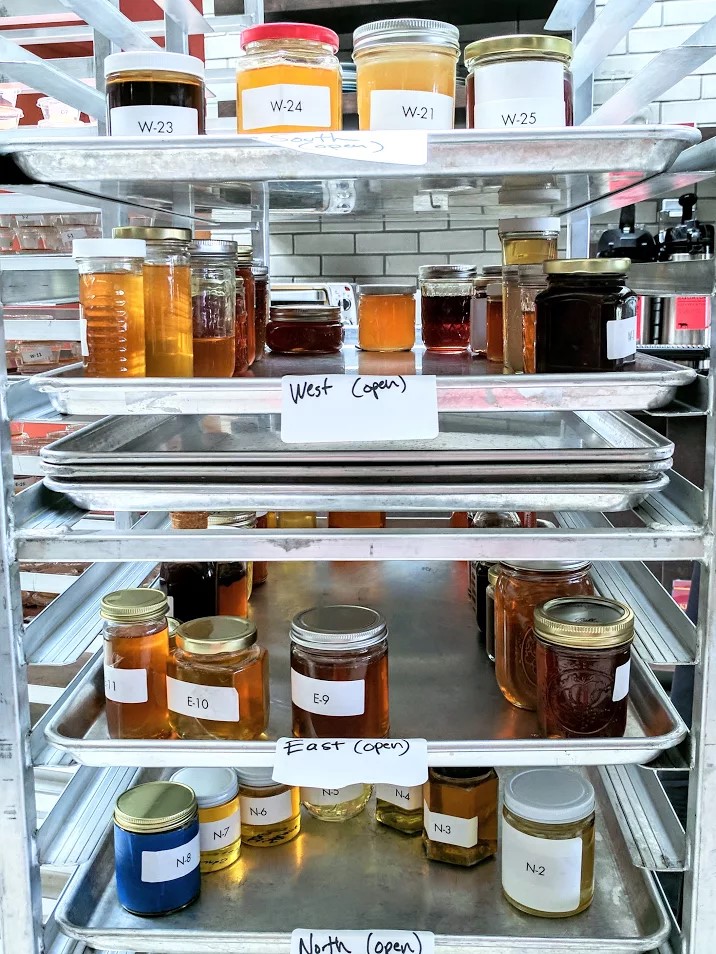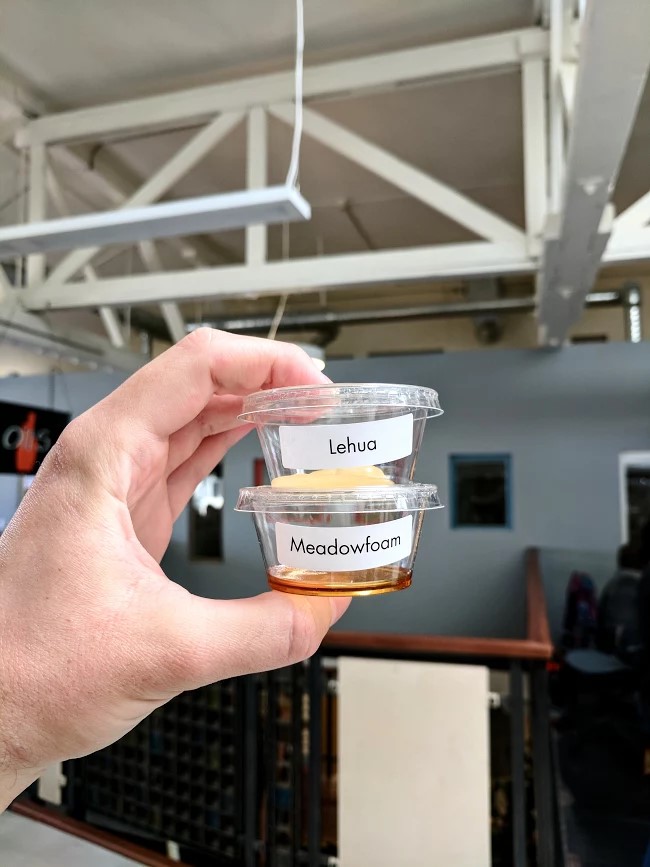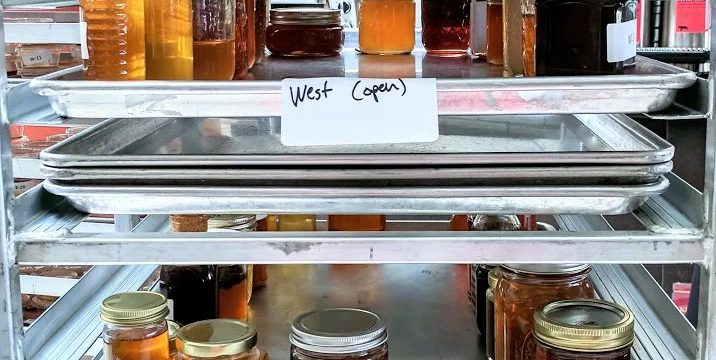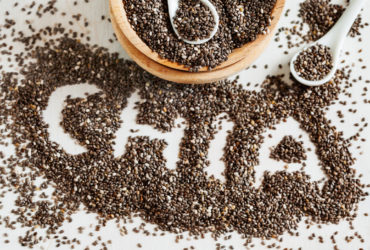BY: MORGAN REASE
Honey, or as it’s known among some Silicon Valley types – “buzz custard’, is awesome. Whether it’s fermented into mead, sweetening some delicious baklava, or providing contrast in a breakfast burrito (Seriously try it. You won’t be disappointed), honey is just plain good. On top of that, honey is one of the world’s oldest foods (1,2). It can even be found in ancient Egyptian tombs- but what is honey anyway?
When most people think of honey, they think of the thick, golden-amber syrup that comes in a jar or a cute squeezable bear from the store. Most people — hopefully — know that honey is made by bees. But honey isn’t just one static product. Honey has an amazing array of complex varieties, and there’s a lot of cool science in those jars!

Image 1: An amazing array of honey varieties. Honey can range in color from nearly pure white to almost black, and in texture from a thin syrup to a very thick paste.
Regardless of varietal, there are some commonalities between various honeys. Honey is a flavorful sugar syrup produced by honey bees — Apis mellifera — primarily from plant nectars. A small fraction of honey is produced from something called honeydew (not the melon though). Honeydew is a sticky liquid left behind on plants by some insects! Honey is far more complex than its often given credit for, and although they are usually treated as synonymous, honey is so much more than just sugar. It has proteins, acids, enzymes, flavor and aroma compounds, minerals and more! Even the sugars are varied in structure and ratio between different honeys.

An example of honeydew honey
Table 1: Chemical composition of the average US honey (1)
| Component | Average % |
| Water | 17.2 |
| Fructose | 38.4 |
| Glucose | 30.3 |
| Sucrose | 1.3 |
| Other Disaccharides | 7.3 |
| Higher Sugars | 1.4 |
| Gluconic Acid | 0.57 |
| Acids (not including gluconic) | 0.43 |
| Lactones | 0.14 |
| Minerals | 0.17 |
| Nitrogen | 0.04 |
Now that we’ve cleared up what I mean when I say honey, let’s take a closer look at how bees actually make this honey. When a worker bee visits a flower, it drinks it up the nectar with a long tubular tongue, called a proboscis. Then part of the honey goes to the stomach to be used as food, but a large portion goes to a special organ called a honey sac. The honey sac stores nectar and incorporates enzymes to prepare it for its long journey to becoming honey. The transformation from nectar to honey involves many steps, which are collectively called ripening.’
Among the cocktail of enzymes that the nectar will encounter on its journey are amylases, which convert large carbohydrate molecules into smaller ones (e.g. starch into glucose) ; invertase, to convert sucrose to its composite sugars: glucose and fructose; and glucose oxidase, to produce gluconic acid, the primary acid found in honey.
The worker bee visits many more flowers, repeating the process each time, until it eventually flies back to the hive. The worker bee will then work with a different bee, called a house bee (a younger house bee bound to the hive), to concentrate the nectar and get those enzymes working. They’ll pump the nectar in and out of their honey sacs, pass it back and forth, allowing the exposed nectar to concentrate by virtue of evaporation until the moisture content goes from about 80% down to 40-50%. The remaining bead of liquid then gets deposited into part of the honeycomb along with more beads from other bees. The bees then work to concentrate the honey even more by literally fanning it with their wings, causing evaporation. Eventually the moisture level drops down below 20% and the bees will then seal off that section of the honeycomb with wax.

Types of honey bees
For every one pound of honey able to be collected, about eight pounds will have been consumed by the bees to fuel to the daily activities of the hive (4). That’s a lot of work by the bees to make all that honey! It’s estimated that the bees would have traveled the equivalent distance of three trips around the world just produce those nine pounds of honey!
At this point the beekeeper can come to take the comb away. The honey will then get separated out from the comb via a centrifuge, and will be passed through a coarse filter. Unless you’re buying a literal honeycomb, the honey you eat has been filtered at least this once to remove chunks of wax and the occasional bee part — even those jars labeled as “unfiltered” (apparently this first filtration doesn’t count). Honey can be further treated for quality reasons. It can be heat-treated to make it easier to pack and deactivate yeast, which could cause fermentation, and honey can be ultra-filtered to inhibit sugar crystallization.

Example of a honeycomb
We’ve all taken an old honey out of the cupboard to find the bottom caked with sugar crystals. It’s important to note that crystallization does not mean that the honey has gone bad. In fact, all honeys will eventually crystallize. To return a honey to its liquid state, one simply needs to heat it up. Leaving the honey in hot water will do the trick, or you can even give it a quick zap in the microwave. Warmer temperatures increase the ability of water to solubilize sugars, banishing the crystals from your delicious liquid honey.

Crystallized honey
When stored properly, honey has a practically indefinite shelf life because its composition gives it a robust defense against spoilage. It has an extremely low water content, around 20%, which inhibits bacterial growth. The acids in honey give it a low pH, around 3.9, which also inhibits the growth of spoilage microorganisms. Honey even contains antiseptic compounds like hydrogen peroxide! However, honey CAN spoil if it’s kept in a humid environment. If honey is allowed to absorb too much moisture from the air, it can permit yeast to grow and begin to ferment the sugars in the honey. Honey can also contain spores from Clostridium botulinum, which is a major food-safety risk for babies as their digestive systems are not yet developed enough to prevent the spores from germinating and releasing botulinum toxin. The risk of C. botulinum spores in honey is why it is strongly advised that you don’t feed any honey to babies less than 1 year old.
Going back to the issue of crystallization, crystal formation is just the sugar coming out of solution. Two of the most abundant sugars in honey — glucose and fructose — play a big role in determining a honeys texture. The key term here is saturation point. When dissolving a substance in water, eventually a point is reached when no more of that substance can dissolve – the saturation point. Glucose reaches its saturation point at far lower concentrations than fructose does (1). Therefore, honeys with higher glucose contents crystallize more readily than honeys with higher fructose contents.
Differences in honey varietals, including the propensity of a honey to crystallize, stem from differences in chemical composition. “How can honeys be so different from one another?” you might be thinking. Bees + Nectar = Honey, seems pretty standard to me. “What am I missing?”. The answer is in the nectar.
Bees gather nectar from a lot of different sources. Which flowers provide the nectar to the bees has a great impact on the final honey, as different floral sources have very different nectar compositions. Let’s take a step back and answer the question “what is nectar?”. All nectar is a sugary solution, just like honey. However, the sugar concentration is much lower. As with honey, the nectar can be comprised of different ratios of sugars like glucose, fructose, and sucrose. The sugar composition in the nectar impacts the sugar composition of the final honey. In addition to sugars, nectar contains an abundance of amino acids. Even though it’s the second most abundant component within nectar (not counting water), amino acids comprise just 0.002% – 4.8% by mass of nectar (1). When the protein content is high, as is the case with buckwheat and chestnut nectars, the honey ends up being darker in color. The proteins react with the sugars over time to produce flavorful compounds and dark pigments via the maillard reaction (4). Mineral content also varies greatly between nectar sources, and impacts final color and flavor.
In Table 2 below, the chemical composition of honey is once again provided for reference. Unlike Table 1, at the beginning of the article, Table 2 shows the range of values for each reference component. As you can see, compositions can vary wildly.
Table 2: Chemical composition of the average US honey and ranges for values (1)
| Component | Average % | Range % |
| Water | 17.2 | 12.2 – 22.9 |
| Fructose | 38.4 | 30.9 – 44.3 |
| Glucose | 30.3 | 22.9 – 40.7 |
| Sucrose | 1.3 | 0.2 – 7.6 |
| Other Disaccharides | 7.3 | 2.7 – 16.0 |
| Higher Sugars | 1.4 | 0.1 – 3.8 |
| Gluconic Acid | 0.57 | 0.17 – 1.17 |
| Acids (not including gluconic) | 0.43 | 0.13 – 0.92 |
| Lactones | 0.14 | 0.0 – 0.37 |
| Minerals | 0.17 | 0.02 – 1.03 |
| Nitrogen | 0.04 | 0.0 – 0.13 |
Let’s take a look at some of the different kinds of honey available on the market. Table 3 gives a brief outline of some of my personal favorite varieties.
Table 3: Description of Some Select Varietals of Honey
| Buckwheat | Buckwheat honeys are extremely dark in color thanks to pigments produced from amino acids reacting with the sugar. They can have a robust flavor, often described as malty. Malt flavor is partially due to the presence of the chemical compound methylbutanal (4). |
| Clover | Clover honey is one of the most common varieties; its flavor profile and appearance could be considered the standard by which other honeys are compared. Flavorwise, it has notes of spices like cinnamon, nutmeg, and can have toasted sugar flavors, like caramel or maple syrup. Clover is probably what you think of when you think of honey. |
| Lehua | A very light, nearly opaque white honey produced from lehua flowers in Hawaii (3). It is fairly mild in flavor, like a light, floral caramel. The texture of lehua is its most distinctive feature; it is very thick and crystalline. |
| Orange Blossom | Orange blossom honey is another very common variety. An orange-blossom honey can have a floral aroma, smelling like citrus and jasmine. Its flavor profile is fruity, with brown sugar and toffee notes. |
| Wild Flower | Wild flower honey doesn’t have a dominant floral source, so its not sold under any specific name. Which flowers are available for bees to gather from is dependent on the region and the season. Wild flower honeys from different places, or even from the same place and different seasons, will taste and feel very different. |
Honey truly is an incredible product. Because most of us aren’t involved with, or even familiar with, the production process it’s easy to let the extraordinary become mundane. Thankfully, there are people all over the country for whom honey is not mundane. The bee keeping community is quite large in the US, ensuring a limitless supply of unique and interesting honeys. I suggest you try out some of the honey from your community. While doing so, keep in mind all the cool chemistry involved in transforming nectar into honey. There’s a great big world of chemical reactions all around us! Science has never tasted so sweet.
Works Cited
-
Ball, David W. “The Chemical Composition of Honey.” Journal of Chemical Education, vol. 84, no. 10, Oct. 2007, pp. 1643–1646.
-
Geiling, Natasha. “The Science Behind Honey’s Eternal Shelf Life.” Smithsonian.com, Smithsonian Institution, 22 Aug. 2013, www.smithsonianmag.com/science-nature/the-science-behind-honeys-eternal-shelf-life-1218690/.
-
Honey and Pollination Center at UC Davis. “Lehua Honey.” Ucdavis.edu, UC Davis Honey and Pollination Center, honey.ucdavis.edu/learn/lehua-honey.
-
McGee, Harold. “Sugars, Chocolate, and Confectionery.” On Food and Cooking: the Science and Lore of the Kitchen, Scribner, 2004, pp. 663–667.






i really like food network because it has a schedules so you can know when your favorite shows are gonna start and have great tips.sidr honey pakistan
very amazing you are provide very detail information about honey, like types of bees ,and what is find in honey & what quantity very interesting keep sharing such kind of informative info.Sider Honey Pakistan.